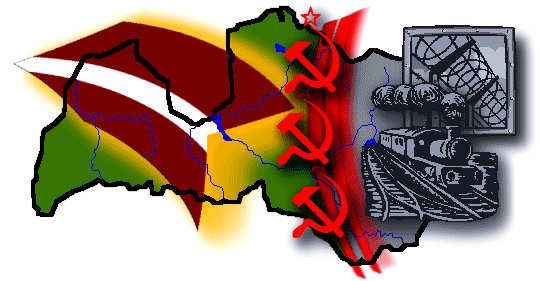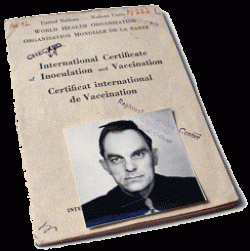Fleeing the second Soviet occupation

Our parents' generation was forced to flee into exile to escape the Soviet re-invasion of Latvia. Nothing matched the dread of, or hatred for, the Soviets, who had instituted a campaign of mass deporations and outright murder during their first occupation, which came to be known as the Baigais Gads, the "Year of Terror."
The Nazi invasion interrupted that brutal occupation. At first greeted as liberation from the Russians, one horror only replaced another. When the Germans retreated, a choice of one evil over the other was the only option to escape the coming Soviet onslaught. Many made it to the Baltic coast and escaped by boat from the ports of Liepaja and Ventspils—Peters' mother recounted she pulled her scarf over her face so she couldn't see the bombshells dropping in the water and sinking the other transport ships around them.
 Peters' father's inoculation certificate, issued at Wentorf
Peters' father's inoculation certificate, issued at WentorfAnd so began life as refugees for the better part of a decade. The DP camps were administered by the United Nations Relief and Rehabilitation Administration (UNRRA), but beyond that, camps' inhabitants were largely self-organized and self-managed. Latvians published their own newspapers and periodicals, staffed their own medical facilities and schools, and carried on their cultural life through art, crafts, literature, and music. (Peters' father was an art teacher.) Their hope for home had not yet dimmed—fleeing into exile, many, like Peters' godfather, had buried family valuables for their eventual return, never thinking they would not live to see their homeland again.
As much as we identify with our Latvian roots—feeling at home in Latvia with our relatives, seeing the sights we learned about as children “growing up Latvian” in a country foreign and strange to our parents—the joy of visiting the land of our heritage can't erase the bittersweet knowledge that we should have been born and raised in a free Latvia. Our parents passed their pain of separation on to us—an unfathomable loss, real and palpable. But, more, they passed on the love of their country and their heritage.
A chronicle of DP life — Answer for Anne
Peters' parents arrived in America thanks to sponsorship by Latvians already here, and through the aegis of Lutheran World Action and the National Lutheran Council. Their post-WWII film urging Americans to welcome refugees into their hearts and communities has been posted on YouTube.
Produced by Lutheran World Action and the National Lutheran Council in 1949, Answer for Anne tells the story of Displaced Persons (DPs) in post-war Europe, and the services provided by the agencies that would eventually become Lutheran Immigration and Refugee Services (LIRS). Starring Lenka Peterson, Will Geer, and Harvey Stevens. 40 minutes. From 1990 LIRS reissue.
The video is set to start where Anne is about to be shown a film of Latvian DP life at "Camp Valka" in devastated post-WWII Germany. The camp was named for the town of Valka, straddling the border with Estonia and its "twin" Valga. The town was divided after Estonia and Latvia declared independence in 1918.
Australian refuge
We invite you to check out the biography of Anna Apinis, who immigrated to Australia after WWII. Anna dedicated herself to preserving the art of Latvian weaving, working on a loom built from scavenged materials in the DP camps in Germany, bringing it with her to her new life in Australia. Read more here:
- The Apinis Loom, at VICTORIA COLLECTIONS
- Weaving was my love: Anna Apinis, at LAPA Muzejs (Latvians in the World Museum)
We have a very personal connection here. Anna married Peters’ mother's first cousin, Ervīns. After the war, those who had once lived within walking distance in childhood found themselves oceans, continents—10,000 miles—apart after the war—never to see each other again.
DP-era materials on our site
Read more
- Camps in Germany (1944–1951) for refugees from Baltic countries, Latvia page, at the Latvian National Archive
- DP camps in Germany, at the Latvieši Pasaulē, Latvians Abroad, Museum
- Cultural Nationalism in Exile, The Case of Polish and Latvian Displaced Persons, Laura June Hilton, Muskingum University, 2009, at researchgate.com
- A personal DP camp research page (not ours)
- “No Home To Go To”, about an exhibit at the Balzekas Museum telling the story of thousands of refugees from the Baltic countries who fled to the West as Russian Communists occupied their homelands in the waning days of the Second World War
- ‘Concerned not only with relief’: UNRRA’s work rehabilitating the Displaced Persons in the American zone of occupation in Germany, 1945-1947, Laura Megan Greaves, Ph.D. dissertation, University of Waterloo, Canada, 2013.
- Fleeing the Soviets
- Our families
- Flensburg DP Camp
 Gallery
Gallery